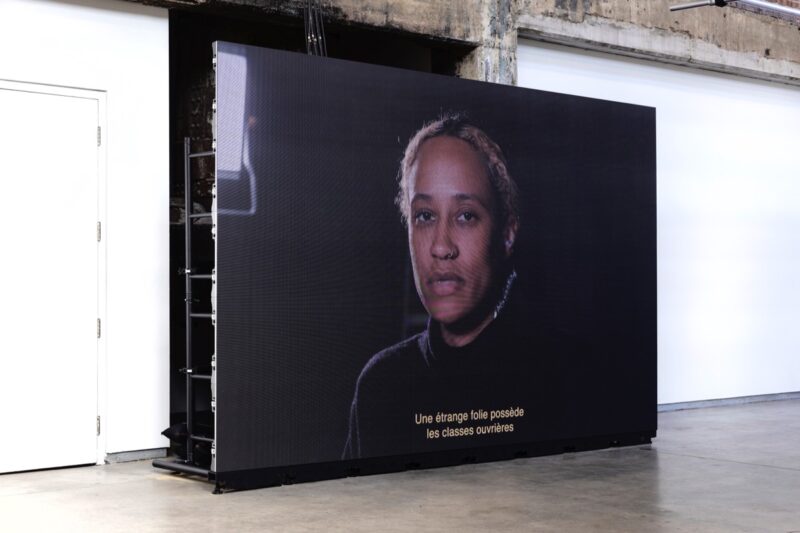[Fall 2024]
Répliques
by Jean-Michel Quirion
Fonderie Darling, Montreal
28.03.2024 — 26.05.2024
[EXCERPT]
After living in Rome for several months, the artist Simon S. Belleau came home to Montreal to present the most important exhibition in his decade-long career: Répliques. His return also brought him back to the Montreal Studios at Fonderie Darling, where he had occupied a space from 2019 to 2023 in the very building where his project is deployed.
For this major body of work, Belleau pursued his deconstruction and reconstruction of the notion of language by interpreting and translating textual and visual elements. He turns to various inspirations to structure his works, including references to theatre and film, and his vocabulary encourages viewers to extend their view beyond the stage or movie set to what is hidden behind the scripts. Répliques was composed in the gap between the director’s work and “geohistorical-social-political” research, with particular attention to the negotiations that take place between what is visible – the performance (in the theatre or on film) – and what is concealed backstage. The precepts that define both playwriting and politics are inherent to his practice. At first glance, the mechanisms used to produce this exhibition seemed to be cloaked from public view. Fonderie Darling was converted not into an amphitheatre but into a space for rehearsal, filming, and even editing, and this processual dimension thwarted apprehension. Nevertheless, Répliques left room for the spectacular through its excessiveness.
The film
Répliques: scènes 1–4 (2024) was shown on a large raised screen in the centre of the large gallery. Its surface was omnipresent in the space, casting a shadow as it blocked natural light. Belleau hired actors. As stage manager and director, he murmured the dialogue to his cast through earpieces clearly shown in the film. There was no dissimulation here. As Milly Alexandra Dery, Fonderie Darling’s curator, states, the whispered words sow uncertainty about “who says what”; they form disconnected (para)language whose original source is not directly accessible. Belleau’s voice thus becomes a pre-echo of will be said. The film’s sequences span four scenarios, narrated, respectively, by the artists Eve Tagny, Frances Adair Mckenzie and David Armstrong Six (as a duo), the singer Anna Arrobas, and the actor Dominick Rustam. A final scene is built on a remake of country singer Gillian Welch’s cult hit “Everything Is Free” (2001). Written in reaction to the emergence and lack of regulation of music-reproduction platforms, the song seemed to predict the current objections to artificial intelligence, which threatens artists’ intellectual ownership and recognition. Rearranged by Arrobas and sung as a bewitching ode, the song resonated beyond the gallery and seemed to float out of reach. Over the weeks, scenes were added to the production, in the mode of an ongoing montage.
Appropriation – or copying and pasting, to use Dery’s term – of information is fundamental to the assemblage of some twenty works on paper placed here and there on the walls of Fonderie Darling. The series is composed of superimposed posters in non-hierarchical surface structures. Each sheet reveals only one image, the top one. By integrating the supporting medium for the poster, Belleau draws on the intrinsically cumulative and repetitive values of language and images. Like a generative intelligence, he works with materials that he appropriates – or self-appropriates – from his works.
Belleau engaged with the architecture of the space in a logic of inversion – a recurrent strategy in his practice. The monumental and vertical codes of Fonderie Darling’s Main Hall were diverted by a horizontal intervention that symmetrically divided the large gallery: the ceiling was lowered by an immense grid of metal pipes, of the kind used to hang lights above stage sets. The viewers’ gaze, instinctively drawn upward, was thus redirected downward, reducing the scale of the space. This was a highly appropriate decision, providing a reminder of framing standards in film.
Although all art forms are becoming more and more disembodied due to artificial intelligence and a multitude of technologies, Belleau’s show called upon the arts’ propensity for play. As his accomplice and witness, the public took an active role in this conditioned andindeterminate exhibition, whose cogs of conception seemed to be in constant activation. The allusive works are desires to replicate, encouragements to (re)act without the simulated and assimilated influences of the virtual.
[ Complete issue, in print and digital version, available here: Ciel variable 127 – SISTERS, FIGHTERS, QUEENS ] [ Complete article in digital version available here: Répliques]



